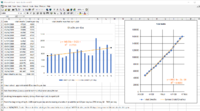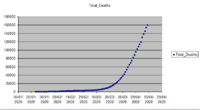If the graph of total deaths is approximately linear, as your R^2 value of 0.9956 suggests, that simply means that the number of deaths per day is approximately constant. That is what your main graph shows, though obviously that is far more variable, as would be expected. The R^2 of 0.2763 means that you can't conclude confidently that there is any real trend there.
For a linear function, doubling time is essentially meaningless. That is significant only for an exponential function, whose doubling time is constant.
In reality, a nearly constant death rate is pretty much what one hopes to see at this stage in an epidemic, because we can hope to manage a constant number of deaths (as long as it is within our health system's capacity). The fear is of exponential growth, which would sooner or later overwhelm the system. What I see in your graph is that "the curve has been flattened", more or less. It isn't ideal, but it is far better than it could be.
It happens that I wrote about the various kinds of graphs we see online in my blog last week, at
https://www.themathdoctors.org/reading-pandemic-graphs/ . I tried to avoid over-interpreting the graphs I showed, because graphs overlook so much (from individual lives, to data collection errors, to the underlying science); the main point is to avoid reading the wrong things into a graph by failing to see it for what it is. I didn't make any graphs of my own showing trend lines and R-squared, though that could have been interesting.


